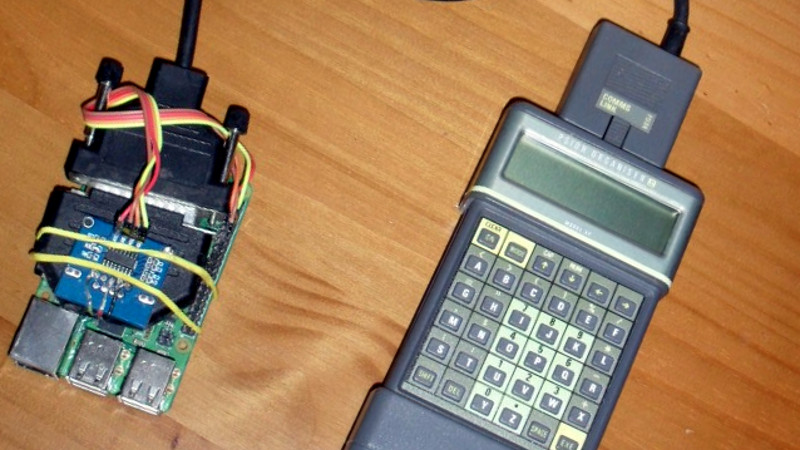Ask a hacker to imagine computing in the 1980s, and they might think of the classic 8-bit all-in-one machines from the likes of Commodore and Atari, or perhaps the early PCs and Macs. No matter the flavor, they’ll likely have one thing in common: a lack of mobility thanks to being anchored down by a bulky CRT screen in the form of either a television or a dedicated monitor. Mobile computing at the time was something of an expensive rarity, consisting of various quirky handhelds that today have been all but forgotten.
Looking to see if one of these so-called “pocket computers” could still be of use in 2019, [James Fossey] set out to get his circa 1986 Psion Organiser II connected to the Internet. With a Hitachi CPU, two-line text-only LCD and ABCD keyboard it’s a world away from the modern smartphone, yet as an early stab at a PDA as well as general purpose computer it’s visibly an ancestor of the devices we carry today. Of course, as the Psion was produced before the advent of affordable mobile data and before even the invention of the Web, it needed a bit of help connecting to a modern network.
Psion sold an RS-232 cable accessory which came with both serial terminal and file transfer in ROM, so with one of these sourced and a little bit of hackery involving an RS-232 to TTL converter and a DB-25 connector, he was able to hook it up to a Raspberry Pi. That means it’s reduced to being a dumb terminal for a more powerful machine that can do the heavy lifting, but those with long memories will tell you that’s exactly what would have been done with the help of a modem to connect to a BBS back in 1986. So far he’s got a terminal on the Pi and a Twitter client, but he’s declined to show us the Hackaday Retro Edition.
Psion has rarely featured directly on these pages, but despite being forgotten by many today they were a groundbreaking company whose influence on portable computing stretched beyond their own line of devices. One we have shown you is an effort to put more recent hardware into a Psion Series 5 clamshell.
















He “declined” to show the Hackaday Retro Edition?
Now thats just rude :(
>> DB-35 connector ???
Yeah, that seems rather dense.
Centronics parallel ports were 36-pin (18×2)
“IBM PC-compatible” were DB25(F) on the devices and (M) on the cables
Let’s give Jenny the benefit of the doubt and pretend they confused the two – you’d often get both on the same cable after all ;-)
The device is capable of showing HaD logo. Using the UDG command in BASIC, one can create up to 8 custom characters for the LCD with resolution 5×8. Maybe not enough for the logo to show statically, but could display it as 4 characters wide on the 2 rows and scroll up and down.
It was quite a smart device. It had a bit strange, yet very capable BASIC compiler (yeah, even though it is strange, it compiled the BASIC to binary and then ran the binaries). You could connect 2 memory devices to it easily, either the Rampaks (up to battery backed 32k RAM), Datapaks (up to 32k of ROM) or Flashpaks (up to 256 kB of Flash).
The 68B03 had enough power to do some crunching with floating point numbers. The compiled programs could call each other. The menu could be rearranged for your needs and the storage devices could have one of the programs configured in such a way that it would run upon powering up the device, thus you could have several distinct working environments just by swapping the memory packs. The expansion port allowed to plug in a laser barcode reader (still trying to find one), which allowed this device to be used for organising stores. And it never turned off, it was just sleeping and periodically checking whether there is some event configured (it had no real RTC, but the 68B03 maintained time) to happen. You could write your own hooks that could be run while sleeping. It could tell you when the battery (9V) was running out.
Oh and did I say the BASIC had a quite extensive support for handling exceptions? It had 64 error codes for errors caused by HW faults (low battery, no memory device inserted, errors upon reading/writing memory devices), software faults (overflow, divide by zero, full memory, stack overflow or underflow), syntax errors (general syntax error, unmatched brackets, invalid characters, subscript errors) and general events (end of file, end of record, …). And if that was not enough for you, you could use the remaining 192 codes fo yourself. And the exception handling could be turned on and off anytime (well, it was strongly advised to always check for low battery during these sections) while still registering those exceptions.
If you want to find out more, look here: https://www.jaapsch.net/psion/manlzpg.htm
Wouldn’t it be a DB-25 not 35 connector? The standard RS-232 connector was a 25-way D-type, with 9-pins becoming more common latterly.
What’s an ABDC keyboard? The keys are arranged in ABCD on the Psion …
DON’T PANIC!
In large, friendly letters on the cover.
“and ABDC keyboard” Never heard of that kind before….